MyPortugalHoliday.com
The best independent guide to Central Portugal
MyPortugalHoliday.com
The best independent guide to Central Portugal
Day trip to Óbidos and a 1-day self guided walking tour
Just an hour north of Lisbon lies Óbidos, Portugal's most enchanting walled town and a perfect destination for a day trip. This medieval gem emerges from the countryside like a mirage, its ancient walls enclosing a perfectly preserved settlement of whitewashed houses and narrow cobbled streets, all watched over by a formidable castle.
The town's fairy-tale appearance is the direct result of a unique royal history. For over 600 years, Óbidos was the personal property of Portugal's queens, a cherished wedding gift, a tradition that began in 1214 with Queen Urraca. This sustained royal patronage ensured the town's immaculate preservation, earning it the celebrated title 'Vila das Rainhas', the Town of the Queens.
Despite its small size, Óbidos is packed with a wealth of attractions. From walking the ancient town walls to sampling Ginjinha (cherry liqueur) in chocolate cups, there is plenty to see and do. This guide provides everything you need for a perfect day trip to Óbidos, including practical travel information, walking routes, and insider tips to help you make the most of your visit
Related articles: Sights of Obidos - Lisbon day trips
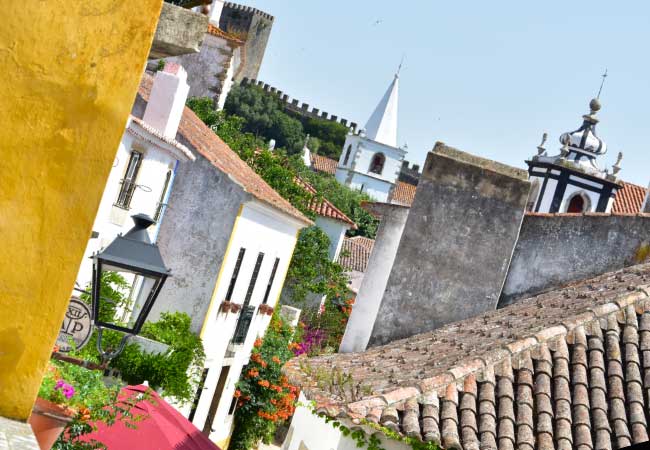
Obidos is one of the prettiest towns of Portugal
Quick Guide: Day Trip to Óbidos
• Cost estimate: €45 per adult
- Bus fare: €18.10 (€9.05 each way)
- Lunch: €17-25
- Glass of Ginja: €2.00-€2.50
- No admission fees for main attractions
• Journey time: 60 minutes by express bus from Lisbon
• Recommended visit duration: 2-3 hours
• Suitable for: All age groups, including families with children
• Accessibility: Cobbled streets and hills may challenge visitors with limited mobility
• Best for: History enthusiasts and those who enjoy picturesque towns
• Peak times:
- Daily: 11:00 AM to 3:00 PM
- Seasonal: July to September
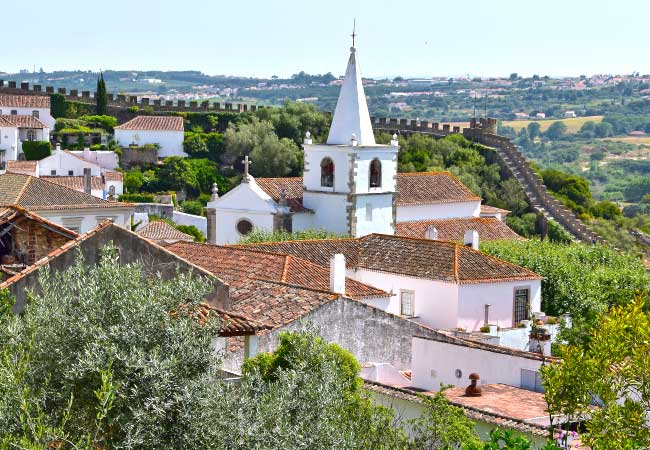
Traditionally, Obidos was a present to the queen of Portugal on her wedding day
A suggested walking tour of Óbidos
The map below shows a suggested walking tour of Óbidos, covering the main sights of the town.
The route starts from the main car park or the bus stop, which are both to the south of the main gate into the town (Porta da Vila). The tour covers a total of 2.1km and will take approximately two hours to complete. The yellow line marks the town walls, which can be walked around and accessed at points 1 or 3.
Legend 1) Porta da Vila Gateway 2) Rua Direita 3) town walls 4) Trilho do Castelo (castle trail) 5) Igreja de São Tiago 6) Castelo de Óbidos 7) Estrada da Cerca Gateway 8) Igreja de Santa Maria 9) Igreja de São Pedro 10) Capela de São Martinho 11) Aqueduto de Óbidos (aqueduct)
The best place to access the town walls is at point 3. This location is less crowded than the Porta da Vila (1) and offers spectacular views of the surrounding landscape.
Insight: The walking tour is explained in-depth later in this guide.
Óbidos does get crowded with tourists
While photographs often portray Óbidos as an idyllic and picturesque medieval town, it is important to understand that it is a very popular tourist destination. The enchanting experience of exploring the town will be shared with hundreds of other visitors, especially during the peak season from July to September
In the summer, the main street, the Rua Direita, is frequently crowded with tourists and large coach tours. To best appreciate the town's unique atmosphere, it is highly recommended to start any day trip early and try to avoid the peak hours between 11:00 AM and 3:00 PM. An excellent alternative is to spend a night within the ancient walls; the town becomes wonderfully peaceful and quiet after 5 PM, once the day-trippers have departed, offering a much more authentic experience
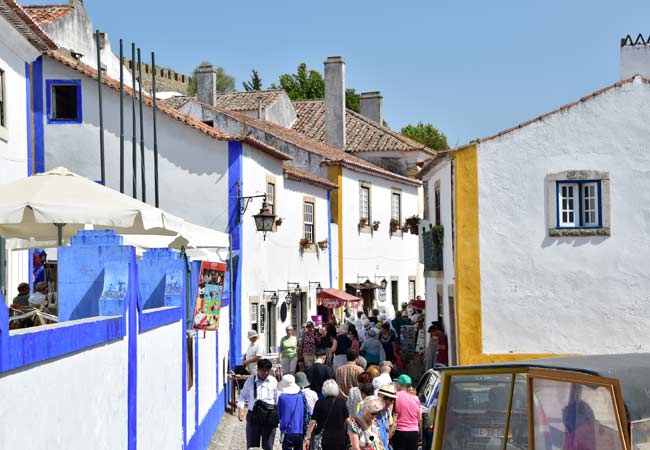
The Rua Direita on a quiet spring day, but there are still lots of tourists!
An organised tour of Obidos?
There are many organised tours that leave from Lisbon and include Óbidos. These day-long tours combine Óbidos with other popular tourist destinations such as Fátima, Nazaré or Batalha.
The advantage of an organised tour is that they provide knowledgeable tour guides and are great if you are limited for time. The main disadvantage of the organised tours, is that they only schedule 40-60 minutes to explore Óbidos, which is not really long enough.
An independent day trip to Óbidos means that you can avoid the peak hours and spend as long as you like within the town. Some of the best tours that include Óbidos are shown below:
Óbidos is only a small town
Óbidos is a relatively small town and all of the tourist attractions can be easily seen within a couple of hours of sightseeing. There are many more tourist attractions in Sintra, Cascais, and Setubal than in Óbidos, but the main appeal of Óbidos is its charm.
If the day trip to Óbidos is too short, we suggest combining it with the town of Caldas da Rainha, Foz do Arelho, Peniche or Buddha Eden:
• Buddha Eden: Situated about 20 minutes east of Óbidos lies the largest oriental garden in Europe. This unique park features an extensive and impressive collection of Buddha statues, pagodas, and terracotta sculptures set within a tranquil landscape.
• Caldas da Rainha: A short 10-minute drive north of Óbidos, this town is famous for its ceramic traditions and thermal springs. It provides a more authentic Portuguese atmosphere with its traditional daily fruit market and the beautiful Dom Carlos I Park.
• Foz do Arelho: Situated about 20 minutes to the west, this coastal town boasts a stunning and unique beach where the calm waters of the Óbidos Lagoon meet the powerful waves of the Atlantic Ocean.
• Peniche: This traditional fishing town, located approximately 30 minutes west of Óbidos, is a major hub for surfers due to its renowned beaches. It is also the departure point for scenic boat trips to the Berlengas Islands nature reserve.

The Lagoa de Óbidos and the beach of Foz do Arelho
Practicalities for a day trip to Óbidos
How to get to Óbidos without a car
Óbidos is 80km north of Lisbon and it is relatively easy to get to there without a car.
An express bus service, the Rápida Verde (Green Express) departs from Campo Grande bus station in Lisbon, and takes approximately 1 hour to reach Óbidos. A single ticket costs €9.15 (return tickets are not available for this route). On weekdays, there are over 30 daily departures, while weekends and public holidays have 13 departures. For the latest timetables and information, visit the Rodoviária do Oeste website. rodoviariadooeste.pt/
(Note: to search on their website Óbidos starts with an Ó and not an O)
Be aware that Campo Grande bus station can be confusing, and it is advisable to arrive with ample time to find the correct departure point. Rodoviária do Oeste buses depart from the eastern side of the bus station - link to google maps. Adding to the confusion, the buses may have the livery of “Rodotejo” a sister company to “Rodoviária do Oeste”.
In Óbidos, the bus stops south of the town, near the Porta da Vila gateway.
Lisbon to Obidos by car
Óbidos is 1km from the A8 expressway, one of the major routes connecting Lisbon and the north of Portugal. Óbidos is at junction 15 of the A8 expressway. Cars are not allowed in the historic centre, but fortunately there are two large car parks to the south of Óbidos (GPS : 39.357, -9.158 and GPS : 39.357, -9.157).
Warning: Never leave valuables or visible luggage in your car, even during peak hours. There have been reports of car break-ins in the area, so it's wise to take precautions.
The A8 expressway from Lisbon to Óbidos is tolled, so it's important to know how to pay these charges before your trip. The most convenient payment method is the Via Verde transponder, which you should request when renting a car in Portugal. For full details on toll payments and the Via Verde system, visit their official website: visitors.viaverde.pt
Insight: Óbidos makes for an ideal stop when travelling from Lisbon to Coimbra or Porto. The town is just 1km from the A8 expressway, making it a convenient and worthwhile detour on your journey north.
Where to go for lunch in Óbidos?
Óbidos offers many decent restaurants considering the small size of the town, but as a popular tourist destination, prices can be comparable to Lisbon, and service may be slower during peak times
Ja!mon Ja!mon - This unique restaurant provides a memorable dining experience beneath the stone arches of the town's 16th-century aqueduct. It specialises in high-quality Iberian hams, regional cheeses, and generous portions of slow-cooked specialities. The tapas-style menu is perfect for a relaxed meal.
A Nova Casa de Ramiro - For a more intimate dining experience, A Nova Casa de Ramiro offers a distinct, cave-like atmosphere ideal for a romantic meal. The menu features classic Portuguese cuisine, complemented by a carefully selected wine list.
Petrarum Domus - This restaurant provides a tradtional dining experience inside the walls, focusing on classic Portuguese dishes executed to a high standard. The interior, with its beautiful stone arches, creates a historical ambiance that perfectly matches the medieval town.
Restaurante Vila Infanta - For authentic, well-priced food where the locals eat, Restaurante Vila Infanta is an excellent choice. Located a short walk from the main walls near the Santuário do Senhor Jesus da Pedra, it offers a respite from the tourist crowds and serves good, traditional Portuguese food at a reasonable price
Alcaide - The main draw of this restaurant is its lovely terrace, which provides diners with wonderful views over the surrounding hills. It is a fantastic spot to enjoy a meal on a sunny day, with a menu that focuses on local specialities.

A suggested walking tour of Óbidos
The map below shows a suggested walking tour of Óbidos, covering the main sights of the town. The tour covers a total of 2.1km and will take approximately two hours to complete.
Guided walking tour of Óbidos
Your journey into the medieval heart of Óbidos begins at the Porta da Vila Gateway (1), the town's main entrance. This double gateway is a masterpiece of medieval military strategy, designed with offset entrances to prevent a direct cavalry charge and make it difficult for attackers to use a battering ram. As you pass through, you enter an ornate oratory with a baroque balcony.
Look up to see the stunning 18th-century blue and white azulejo tiles depicting scenes from the Passion of Christ, while the painted ceiling represents the Crown of Thorns. An inscription, placed by order of King João IV in the 17th century, dedicates the chapel to Our Lady of Pity, the town's patroness.
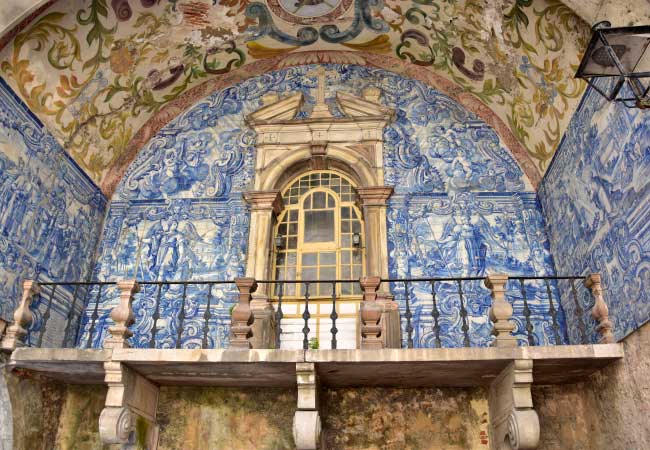
Once through the gate, you will find yourself on Rua Direita (2), the main artery of Óbidos that has connected the gate to the castle since the 14th century. This charming, narrow cobbled street is lined with traditional whitewashed houses, many of which still feature original Gothic doorways and arched windows, hinting at their medieval origins. The street is a bustling hub filled with artisan shops, galleries, and cafes, making it the perfect place to sample the local cherry liqueur, Ginjinha, which is famously served in an edible chocolate cup.
From Rua Direita, you can access the magnificent town walls (3). These fortifications, with sections reaching 13 metres high, form a complete 1.5km loop around the historic centre. Their foundations date back to the Moorish era, and they were later reinforced by Portuguese monarchs and largely restored after the devastating 1755 earthquake.
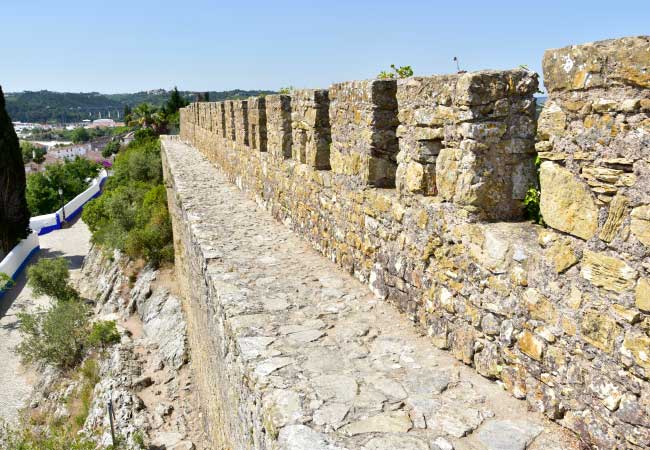
It is remarkable to think that until the 16th century, the sea reached the base of the hill to the west of Óbidos, making the town an important port. A less crowded access point than the main gate is located on the western side of the town, offering spectacular views over the terracotta rooftops and the surrounding countryside.
Following the path towards the town's highest point brings you along the Trilho do Castelo (4), or castle trail. This approach builds anticipation, with the formidable fortress looming above. Nearby is the Igreja de São Tiago (5). Originally built in 1186, this church once served the castle's residents and provided shelter for pilgrims on the Portuguese Way to Santiago de Compostela in Spain. After being destroyed in the 1755 earthquake, it was rebuilt in a completely different style and now has been impressively adapted into a large bookshop and auditorium.
At the northernmost point of the town stands the imposing Castelo de Óbidos (6). This classic medieval fortress, whose origins trace back to a Moorish fortification, is now one of Portugal's most luxurious historic hotels (Pousada). After its conquest in the 12th century, King Afonso II gifted the castle and town to his wife, Queen Urraca, beginning a 600-year-long tradition that saw Óbidos belong to the queens of Portugal, earning it the nickname "Vila das Rainhas" (Town of the Queens).
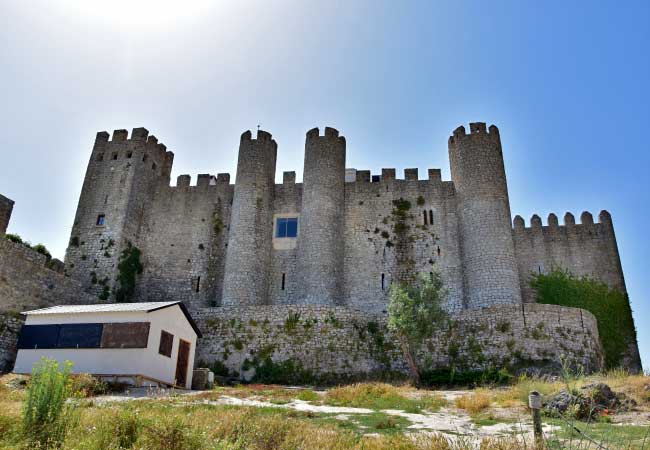
While the interior is reserved for hotel guests, you can freely explore the outer battlements and courtyard to get a fantastic sense of the castle's medieval grandeur. As you descend from the castle, you can pass through the Estrada da Cerca Gateway (7), a historic portal offering a quieter route into the western part of the town.
Your tour continues to the Praça de Santa Maria, the town's main square, which houses the Igreja de Santa Maria (8). This is Óbidos's main church, built on the site of a former Visigoth temple and later a Moorish mosque. The current Renaissance structure hosted the remarkable wedding of a 10-year-old King Afonso V to his 8-year-old cousin, Isabel, in 1444. Inside, you can find significant works by the renowned 17th-century painter Josefa de Óbidos, who lived and worked in the town.
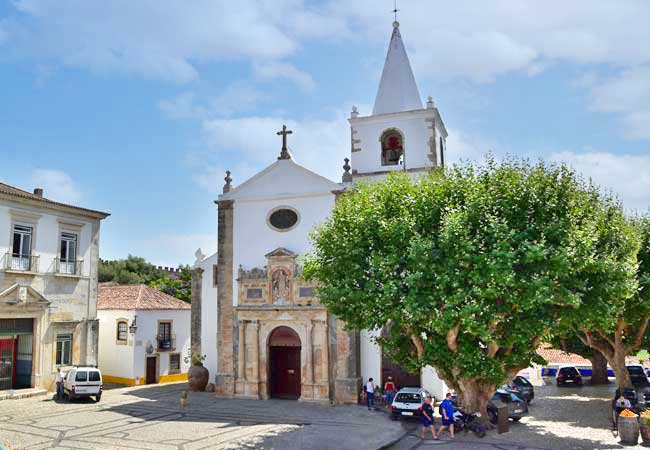
A short walk away is the Igreja de São Pedro (9). Originally a 13th-century Gothic structure, it was significantly rebuilt after the 1755 earthquake, resulting in a blend of Baroque and Neoclassical styles, though it retains its original 17th-century stone portal. The church contains a magnificent gold-covered altarpiece and is the final resting place of Josefa de Óbidos.
Directly opposite stands the Capela de São Martinho (10). Founded in 1331, this small Gothic chapel is a rare treasure, being the only fully intact medieval building in Óbidos. Built as a private tomb chapel, its simple, fortress-like appearance and rib-vaulted interior contain several tombs set into pointed arches in the walls.
To conclude your tour, take a short walk southeast of the town walls to view the impressive Aqueduto de Óbidos (11). This 16th-century aqueduct was commissioned by Queen Catherine of Austria, wife of King João III, to provide a steady supply of water to the town's fountains. To fund the monumental project, the queen sold the lands she owned around Óbidos. The structure stretches for 3 kilometres and is a remarkable example of the ingenuity of Renaissance-era engineering.
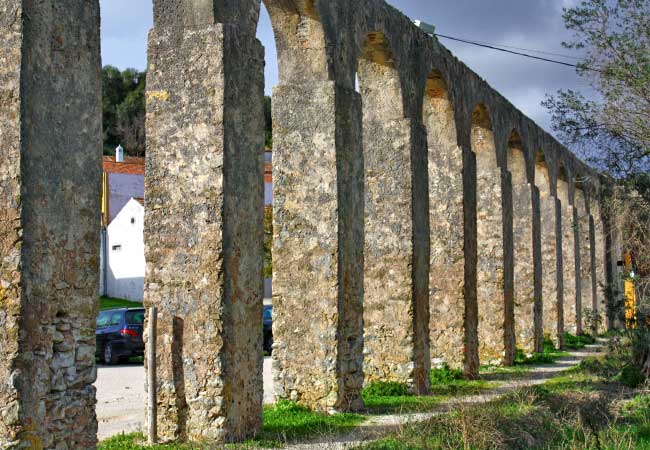
Accessibility
Óbidos, an ancient medieval town, presents some challenges for visitors with mobility issues. The main thoroughfare, Rua Direita, which runs through the town centre, is flat and paved with cobblestones. While this central area is relatively easy to navigate, steep slopes lead west (uphill) and east (downhill) from the main street.
The primary accessibility concerns arise when entering the town's historic shops, cafes, and restaurants. Many of these establishments feature steps, narrow doorways, and split-level interiors, which can be difficult for those with limited mobility.
Despite these challenges, Óbidos is generally more accessible than other popular Portuguese destinations like Sintra.
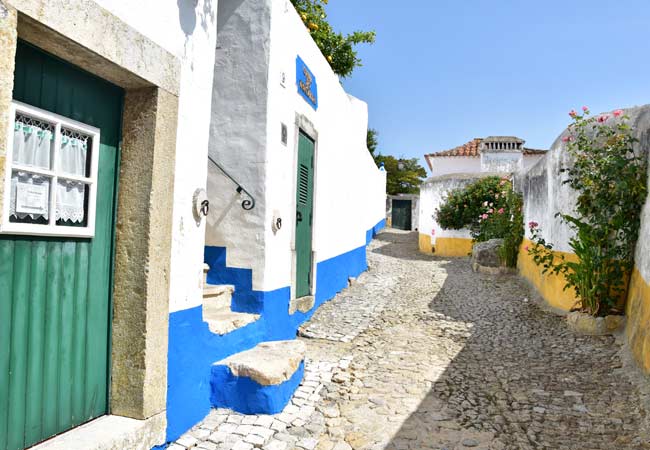
The cobbled streets of Óbidos
Combining Óbidos with Caldas da Rainha
For a day trip that combines a perfectly preserved medieval village with the buzz of an authentic Portuguese city, consider pairing your visit to Óbidos with the nearby Caldas da Rainha. While Óbidos offers timeless charm, Caldas da Rainha provides a vibrant slice of local life and culture, seeing far fewer tourists.
Caldas da Rainha is just 5km north of Óbidos, and the same express bus service connects the two towns, with the journey taking just 10 minutes. At the end of the day, you can catch a frequent, direct bus from Caldas da Rainha back to Lisbon, making it a very convenient two-stop itinerary.
Highlights of Caldas da Rainha include:
• Praça da República (Fruit Market): At the heart of the city is the Praça da República, which hosts the Mercado da Fruta. This traditional, open-air farmers' market has been held daily for over a century and is a feast for the senses. It is the perfect place to experience local life while browsing the stalls of fresh produce, flowers, and regional cheeses.
• The Ceramic Tradition: Caldas da Rainha is nationally renowned for its ceramic arts, a legacy dating back to the 15th century and closely associated with the iconic designs of Rafael Bordallo Pinheiro. You can see this heritage throughout the city, from the Ceramics Museum to the Bordallo Pinheiro factory, famous for its unique cabbage-leaf tableware and other naturalistic earthenware.
• Parque Dom Carlos I: This expansive and beautiful park offers a peaceful green oasis in the city centre. Designed in the Romantic style, its shaded paths are perfect for a stroll around the central lake. The park also houses the Museu de José Malhoa, a notable museum dedicated to Portuguese naturalist painting
Discover more of Óbidos and central Portugal with our guides
If you've found our content valuable, we'd welcome your support.
The digital publishing landscape has evolved significantly. As a small independent publisher, we face growing challenges. Search engines increasingly favour paid content over organic results, while AI-generated content often reproduces original work without attribution.
To support our work, please consider bookmarking this page (press Ctrl + D) for quick access. If you find an article helpful, we'd be grateful if you'd share it with friends on social media.
For specific questions, please see our Reddit community at r/LisbonPortugalTravel.
Should you notice any outdated or incorrect information, please contact us at [email protected]
Thank you for helping us continue to provide valuable content in an increasingly challenging digital environment.

























